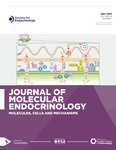Towards an understanding of cell-specific functions of signal-dependent transcription factors
-
Figure 1
Hierarchical organization of transcription factor networks. In the poised or repressed state, closed chromatin at enhancer loci contains motifs for LDTFs. The collaborative binding of LDTFs such as PU.1 and C/EBPs results in nucleosomal-remodeling and basal enhancer RNA transcription at sites containing low H3K4me1/2 and low H3/H4 acetylation. Next, in response to various stimuli, SDTFs, such as LXRs, co-bind with PU.1 and C/EBPs to activate enhancer transcription. Finally, activated eRNA transcription precedes the active deposition of H3K4me1/2 and H3/H4 acetylation. LDTF, lineage-determining transcription factor; SDTF, signal-dependent transcription factor.
-
Figure 2
Histone marks at active and poised promoters and enhancers. Promoters are designated by high levels of H3K4me3, while enhancers contain high levels of H3K4me1/2. In the poised or repressed state, promoters contain histone methylation marks, H3K27me3, and H3K20me3, while enhancers contain H3K27me3/me1 and H3K9me1. Active promoters and enhancers are marked by H3K4me2 and H3K27Ac. GTF, general transcription factor; LDTF, lineage-determining transcription factor; SDTF, signal-dependent transcription factor.
-
Figure 3
Mechanisms for regulating gene expression in macrophages: coregulator exchange from corepressor to coactivator. In the poised or repressed state, the NCOR1/HDAC3/SMYD5 complex inhibits active transcription through de-acetylation of histone H3 and H4, as well as tri-methylation of H4K20. After signal-dependent recruitment of activating transcription factors such as NF-κB, the NCOR1 complex is exchanged for coactivator complexes that remove repressive marks and acetylate histones H3 and H4, recruiting the P-TEFb complex to activate transcriptional elongation.
- © 2013 Society for Endocrinology











